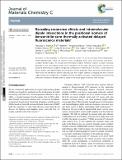Files in this item
Revealing resonance effects and intramolecular dipole interactions in the positional isomers of benzonitrile-core thermally activated delayed fluorescence materials
Item metadata
| dc.contributor.author | Kukhta, Nadzeya A. | |
| dc.contributor.author | Higginbotham, Heather F. | |
| dc.contributor.author | Matulaitis, Tomas | |
| dc.contributor.author | Danos, Andrew | |
| dc.contributor.author | Bismillah, Aisha N. | |
| dc.contributor.author | Haase, Nils | |
| dc.contributor.author | Etherington, Marc K. | |
| dc.contributor.author | Yufit, Dmitry S. | |
| dc.contributor.author | McGonigal, Paul R. | |
| dc.contributor.author | Gražulevičius, Juozas Vidas | |
| dc.contributor.author | Monkman, Andrew P. | |
| dc.date.accessioned | 2019-08-19T12:30:02Z | |
| dc.date.available | 2019-08-19T12:30:02Z | |
| dc.date.issued | 2019-08-14 | |
| dc.identifier | 260662310 | |
| dc.identifier | cbfb4c52-850f-444f-83f4-029a0f07ce93 | |
| dc.identifier | 000478623200003 | |
| dc.identifier | 85073440252 | |
| dc.identifier.citation | Kukhta , N A , Higginbotham , H F , Matulaitis , T , Danos , A , Bismillah , A N , Haase , N , Etherington , M K , Yufit , D S , McGonigal , P R , Gražulevičius , J V & Monkman , A P 2019 , ' Revealing resonance effects and intramolecular dipole interactions in the positional isomers of benzonitrile-core thermally activated delayed fluorescence materials ' , Journal of Materials Chemistry , vol. 7 , no. 30 , pp. 9184-9194 . https://doi.org/10.1039/C9TC02742D | en |
| dc.identifier.issn | 0959-9428 | |
| dc.identifier.other | Bibtex: urn:e3fb1fc6a9786ef575af3fa7c75c7732 | |
| dc.identifier.other | ORCID: /0000-0003-0470-7356/work/61978995 | |
| dc.identifier.uri | https://hdl.handle.net/10023/18335 | |
| dc.description | NAK, HFH, MKE, and APM acknowledge the EU’s Horizon 2020 for funding the PHEBE project under grant no. 641725. NAK, MKE, AD, NH and APM acknowledge the EU’s Horizon 2020 for funding the HyperOLED project under grant no. 641725. APM thanks EPSRC grant EP/L02621X/1 for funding. ANB acknowledges an EPSRC Doctoral Training Grant. | en |
| dc.description.abstract | We report on the properties of the three positional isomers of (2,7-di-tert-butyl-9,9-dimethylacridin-10(9H)-yl)benzonitrile, which are found to have comparable donor steric environments and donor–acceptor dihedral angles. An unexpected intramolecular dipole interaction imparts a unique molecular geometry to the ortho-linked isomer, while comparison of the meta- and para-isomers uncovers how positional differences in acceptor strengths (a consequence of differences in aromatic π-system electron density) lead to very different triplet harvesting and emission properties. These positional-isomer effects on TADF follow the well-known aromatic directing rules from organic synthesis, in keeping with their common origin arising from contributions of multiple electronic resonance structures. Understanding these positional effects and methods of dihedral control is critical to the future design of efficient TADF emitters. | |
| dc.format.extent | 11 | |
| dc.format.extent | 4014509 | |
| dc.language.iso | eng | |
| dc.relation.ispartof | Journal of Materials Chemistry | en |
| dc.subject | QD Chemistry | en |
| dc.subject | DAS | en |
| dc.subject.lcc | QD | en |
| dc.title | Revealing resonance effects and intramolecular dipole interactions in the positional isomers of benzonitrile-core thermally activated delayed fluorescence materials | en |
| dc.type | Journal article | en |
| dc.contributor.institution | University of St Andrews. School of Chemistry | en |
| dc.identifier.doi | 10.1039/C9TC02742D | |
| dc.description.status | Peer reviewed | en |
This item appears in the following Collection(s)
Items in the St Andrews Research Repository are protected by copyright, with all rights reserved, unless otherwise indicated.

